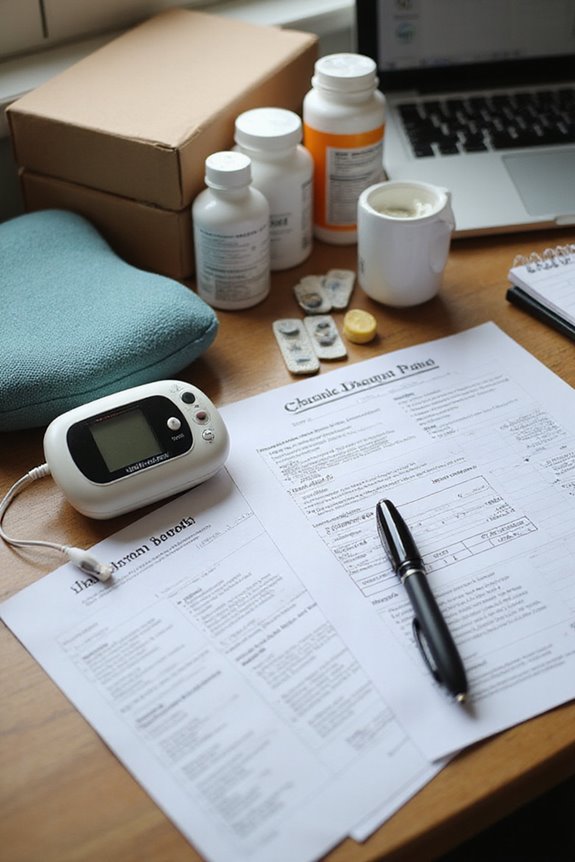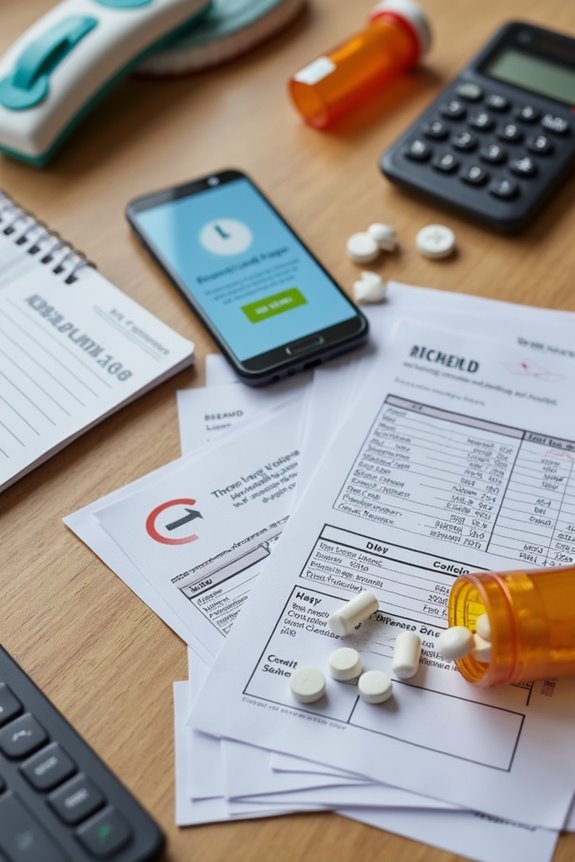Chronic pain can qualify individuals for financial assistance programs due to its substantial impact on daily functioning. Eligibility typically requires documentation of severe impairment, financial need, and lack of adequate insurance. Government options include Social Security Disability Insurance (SSDI) and Supplemental Security Income (SSI). Non-profit organizations, like the American Chronic Pain Association, also offer support and financial aid. Understanding specific criteria and the application process is essential for accessing these resources effectively. Additional details are available.
Key Takeaways
- Chronic pain may qualify for financial assistance programs if it severely impairs daily functioning and meets documentation requirements.
- Eligibility depends on income limits, household size, and residency status in the U.S. or Puerto Rico.
- Programs like SSDI and SSI provide financial aid based on the impact of chronic pain on work capacity and income.
- Non-profit organizations like Good Days and U.S. Pain Foundation offer support and financial assistance to those with chronic pain.
- A formal diagnosis and detailed explanation of financial need are essential for application success.
Understanding Chronic Pain and Its Impact on Daily Life
Chronic pain affects approximately 30-40% of the population in the United States, considerably impacting daily life. This persistent condition can manifest as burning, throbbing, or electrical sensations, often complicating pain management strategies.
Key characteristics of chronic pain include:
- Duration exceeding three months, distinguishing it from acute pain.
- Intermittent or continuous nature, affecting various body areas.
- Potential psychological factors contributing to pain perception.
The impact on daily challenges is profound, with limitations in physical activity and work performance. Chronic pain may lead to additional health issues, including obesity and sleep deprivation, further complicating overall well-being.
Understanding these facets is critical for developing effective pain management approaches and addressing the broader implications of chronic pain on society.
Eligibility Criteria for Financial Assistance Programs

Eligibility for financial assistance programs related to chronic pain requires meeting specific criteria that vary by organization and funding source. Key aspects include:
- Financial Eligibility: Income limits depend on household size and geographic location, with substantial gainful activity thresholds impacting qualification for programs like SSDI.
- Documentation Requirements: Applicants must provide detailed medical records confirming severe impairment and its effect on daily functioning. Healthcare provider verification is often necessary.
- Residency and Citizenship: Permanent legal residency in the U.S. or Puerto Rico is typically required, with specific documentation needed.
- Insurance Status: Lack of adequate insurance coverage or proof of denial is essential for many assistance programs.
Understanding these criteria can help individuals navigate the financial aid landscape effectively.
Government Assistance Options for Chronic Pain Sufferers

Maneuvering the landscape of government assistance options for individuals suffering from chronic pain can be complex. Various government resources are available, including:
- Social Security Disability Insurance (SSDI): Offers benefits for those whose chronic pain affects work capacity.
- Supplemental Security Income (SSI): Financial aid for low-income individuals with disabilities due to chronic pain.
- Medicare: Covers certain chronic pain treatments for eligible beneficiaries.
- Medicaid: Provides state-based financial assistance and health coverage, subject to specific guidelines.
- Veterans Affairs (VA): Offers compensation and healthcare services for veterans experiencing chronic pain related to military service.
These programs aim to alleviate financial burdens and guarantee access to necessary treatments for chronic pain sufferers across the country.
Non-Profit Organizations Offering Support

Non-profit organizations play a significant role in supporting individuals affected by chronic pain, providing various resources and assistance programs.
American Chronic Pain Association (ACPA)
- Established in 1980, ACPA offers support groups across the U.S., typically with 10 members.
- Focuses on constructive pain management techniques and provides educational materials.
Good Days
– This organization alleviates burdens from chronic illnesses, offering financial assistance and advocacy for patients.
U.S. Pain Foundation
– A 501(c)(3) nonprofit providing patient support, advocacy, and educational events to improve quality of life.
Hope Charities
– Offers counseling and financial aid, assisting with medical bills and treatment costs.
Accessia Health Financial Assistance
– Provides aid for travel, medical expenses, insurance premiums, and medication copays.
Disease-Specific Financial Assistance Programs

Disease-specific financial assistance programs provide critical support for individuals managing chronic pain and related conditions. These programs often include:
- Disease-Specific Funding: Allocated for chronic pain-related illnesses, covering medication copayments, insurance premiums, and transportation costs.
- Accessibility: Many foundations, such as the PAN Foundation, offer 24/7 online applications and eligibility criteria by disease name, simplifying access to chronic pain resources.
- Comprehensive Coverage: Assistance extends beyond medical expenses, addressing non-medical costs like housing and transportation.
- Collaborative Networks: Some programs partner with pharmaceutical companies to reduce medication costs essential for chronic pain management.
These resources are crucial for patients seeking financial relief while maneuvering through the complexities of chronic conditions.
The Application Process for Financial Aid
The application process for financial aid in chronic pain management involves several key steps that applicants must navigate to secure necessary support.
Application Requirements:
- Completed financial assistance program application form.
- Supporting documents, including last year’s tax returns, bank statements, or proof of income.
- A formal diagnosis of the chronic condition.
- Detailed explanation of financial need.
- Agreement to program terms and conditions.
Submission Methods:
- Multiple submission options, including online forms, printed applications via mail, or in-person submissions.
- Contact support offices for guidance on the process.
- Downloadable application forms may be available for completion via email or postal service.
Accurate completion of all requested information minimizes processing delays and guarantees timely assistance.
Reducing Financial Burden Through Available Resources
Reducing the financial burden associated with chronic pain management is achievable through various available resources. Patients can explore national and charitable financial assistance programs designed to help with treatment costs.
- The National Financial Resource Directory offers a centralized platform for accessing multiple aid resources.
- The PAN Foundation provides disease-specific grants for medication copays and related expenses.
- Good Days and Hope Charities offer financial coping through direct assistance for medical bills and counseling services.
- HealthWell Foundation focuses on covering premiums, deductibles, and travel costs.
Additionally, specific programs target prescription medication expenses, ensuring that patients receive the necessary treatments without overwhelming financial strain. By leveraging these resources, individuals can effectively manage the financial challenges of chronic pain.
Frequently Asked Questions
Can I Apply for Financial Assistance if I’m Working Part-Time?
Individuals working part-time may still qualify for financial assistance, depending on income verification and program eligibility criteria. Evaluating part-time eligibility varies among programs, but many consider financial need alongside employment status, providing potential support.
How Long Does It Take to Receive Financial Assistance Approval?
Maneuvering the labyrinth of the approval process, individuals often find that the application timeline can stretch from months to over a year. Each step requires patience and resilience, as perseverance ultimately paves the path to assistance.
Are There Age Restrictions for Financial Assistance Programs?
Age limitations greatly impact eligibility criteria for financial assistance programs. Various programs impose specific age requirements, ensuring resources target populations most in need, ultimately shaping access to necessary support for individuals across different age groups.
Can I Receive Assistance for Multiple Chronic Conditions?
Ironically, while chronic conditions often burden individuals, financial aid programs exist to alleviate that burden. Many patients can receive assistance for multiple chronic conditions, managing complex eligibility requirements to find necessary support and belonging.
What Happens if My Condition Improves After Receiving Assistance?
Condition improvement greatly impacts assistance, as beneficiaries must report changes. Improved health may lead to reduced financial support or eligibility, emphasizing the importance of transparency and timely communication with the assistance program for continued support.





